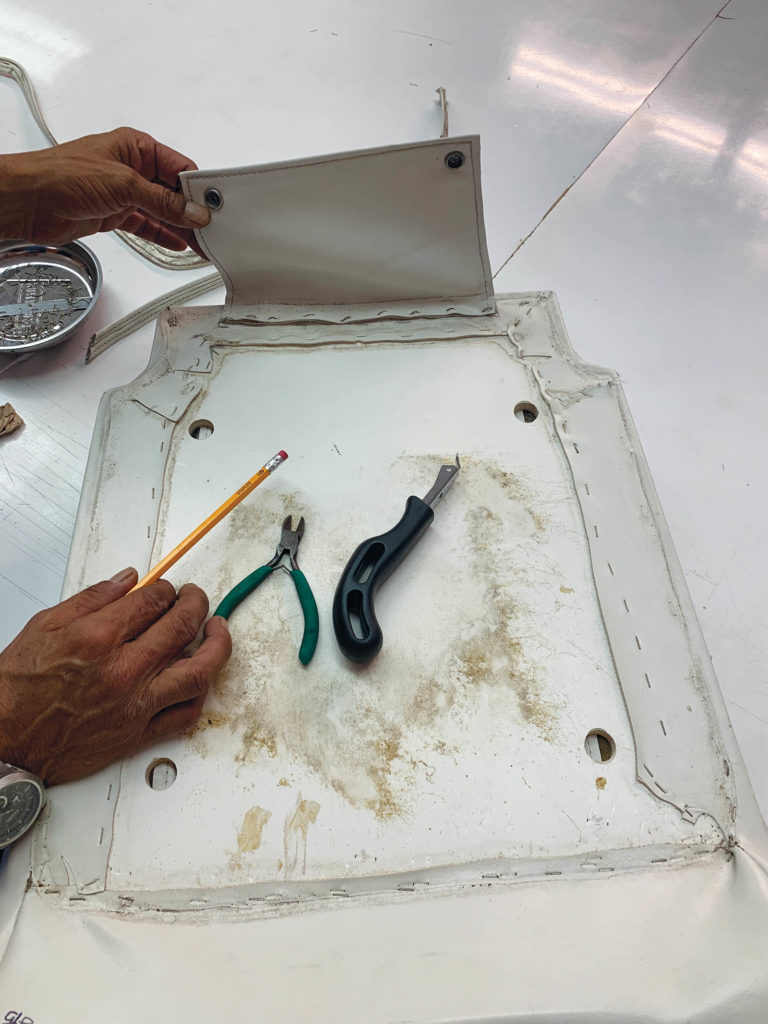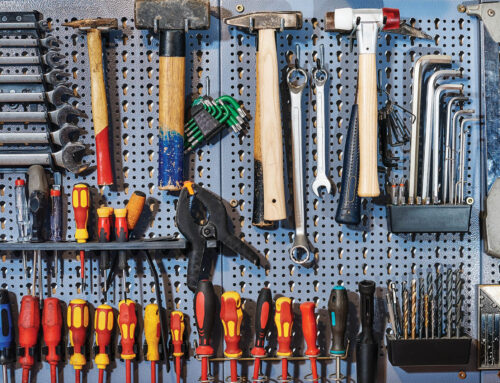Part Two: Knee-rise lumbar cushions stapled to a firm base
By Terri Madden
In the January/February 2020 Marine Fabricator article “Part One: Fabricating knee-rise contour cushions,” I walked you through the steps to fabricate hi/lo knee-rise marine seating independent of a firm base. To achieve a similar stylish and impressive result, you can also fabricate this type of seating using a wood or PVC base. Both approaches have their pros and cons, and both should be evaluated and offered to your customers with the following parameters in mind:
- The fabricator’s skill level
- The customer’s budget
- The size of the seating in a permanent location versus seating that is stowed
- The additional weight of the seat

In this article, I will discuss the fabrication steps for a contour cushion stapled to a firm base. I will also touch on the use of manufactured cushions and the situations in which you may wish to consider these for your clients. No matter the fabrication source, when it comes time for your customers to relax and cruise at sea, the goal is to provide seating with a dynamic appearance that is:
- Ergonomically correct
- Comfortable
- Functional
- Easy to maintain
Manufactured seating
Our shop recently received a request to redo the upholstery for an interior captain seat on a 2015 Sea Ray. I was surprised to see the deteriorated condition of the original Ultraleather® seat by a major manufacturer. Although the seat was no longer under warranty, the original manufacturer, STIDD Systems Inc., based in Greenport, N.Y., did provide replacement component descriptions and pricing that we decided to offer our customer.
Using manufactured seating can be a good option for a shop under a variety of circumstances, including:
- You are on a tight schedule during your busy season.
- Shipping and handling fees charged by the manufacturer are included in the customer’s total cost.
- Your shop is short staffed.
- The type of seating exceeds the skill level of your shop.
- You need to outsource embroidery work that requires marine UV thread.
Seating foam options
Shop owners typically nose around for the best prices; however, most will also have preferred suppliers for materials. We source vendors who are reliable and who offer the quality and shipping options that meet our needs. Consider yourself fortunate if your vendors offer delivery services, although receiving materials via air or boat can add considerably to your costs.
Recently, we sourced seating foam from IFAI member company Active Foam Products Inc., which has several locations in the Midwest. This company offers several types of foam, including marine foam in numerous densities and in every shape imaginable. To contact the company for a catalog and free foam samples, visit www.activefoam.com.
Editor’s Note: In addition, Allied Aerofoam Products LLC at www.alliedaerofoam.com and Albany Foam and Supply Inc. at www.albanyfoam.com were recommended by 2020 MFA Conference participants.
The suggestions and techniques outlined in the following sidebars and in Part One of this article will help you increase your contour cushion expertise and expand your customer offerings. As you become more familiar with patterning and final foam sizes, you can work the material to fit almost any shape desired. Adding small details, such as beefy topstitching and bonus drink holders, will enhance the cushions’ appearance and ensure your customers’ enjoyment. These details will also garner appreciative glances in the marina and are sure to generate future business for your shop.
Terri Madden owns Sand Sea & Air Interiors Inc. in San Juan, Puerto Rico. www.sandseaair.com.
SIDEBAR: Hi-lo cushion how-to
Basic pilot seat with a firm base

Start with a marine-quality base material in good condition. Your cover will need to fit tightly and will be attached to the base with stainless steel staples. Common base options include Sintra® PVC, King StarBoard® High-Density Polyethylene and marine plywood. All of these will withstand the challenging marine environment. Your exterior material should be marine-grade vinyl or fabric with excellent UV protection and stain resistance. Consider the following items during fabrication:

- Pattern the area for contours, if needed. Determine the final length, width and band length and height of the seat.
- The base material should be 1/2 inch to 5/8 inch thick with smooth edges on all sides. Include air holes for moisture evaporation, approximately two to four for a 16-inch section.
- Indicate hi-lo areas on the base material. These will be your staple lines to achieve a hi-lo cushion.
- Prep the marine foam and cut it slightly larger than the base sections. We use firm-density foam for seats and a medium-firm density foam for the back areas.
- Consider using a 1/2-inch to 1-inch topper in a layer of Dacron® to give it a soft loft.
- Prep the pattern sections from the foam contours. Cut new material with seam allowances for the tops, sides and a back flap, if required, to secure the seat via snaps on the base.
- Assemble the upper sections with interior staple bands sewn next to the center seam lines. Include single or double topstitching along the sidebands.
- Glue the center seat foam to the base. Staple interior bands fore to aft at divisions.
- Glue the side seat foam to the base and check the fit.
- Confirm sideband fit and taper the edge that will be sewn to the top of the seat. This band will narrow as it crosses the center panel. It will be higher as it transitions along the hi sides and seam joints at the center back.
- Staple the cover along the side bottoms to the base.
- Add piping around the seat edges for a finished look.
- Prep and staple the back-snap flap to secure the cushion to the underside of the pilot seat.
Details for a two-person seat:
- Join the three vertical panels with interior staple flaps.
- Join the horizontal line with an interior staple flap.
- Staple the horizontal flap followed by the vertical flaps.

 TEXTILES.ORG
TEXTILES.ORG 







